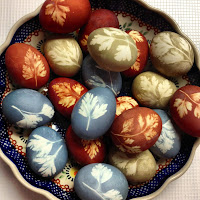 |
| Onion skin dyed eggs are a beautiful warm brown. Old tradition: rub crosses on them. New tradition, use leaves to decorate. |
As
a little girl, Easter was always an exciting time. Usually on the Thursday evening, after going
to church for the Vodnaluvah/foot washing, we would come home to dye our
Easter eggs. We had all those cool
colors – the tablets that you drop in the warm water with a spoonful of vinegar, the little
copper metal scoopy thing that looked like a bent paperclip, the white crayon for writing people’s names. And every year, my little brother would always try
to make a half and half egg and accidentally drop his still wet dark green egg
into the beautiful yellow mixing the colors. That would get me so mad! By the end of the evening we had a mess on our table. But it was a lot of fun. We were blessed to have my grandmother live
right on the corner of our street. She
was over everyday, and she would bring over her carton of eggs, her special eggs, that she had dyed with onion skins.
They were all one color – a warm dark brick color with crosses rubbed on
them. This was the traditional Armenian way of coloring eggs. No gimmicks. Just basic.
Simple, natural dye using what our people had. They were survivors. Nothing went to waste. The skins of the onions were used to color
the eggs.
 |
| Still doing the traditional onion skin eggs but also trying other natural dyes like red cabbage (blue) and beets (khaki) |
You all know about my empty nest. Last October, my daughter Ani got married, and this was my first year in 25 years that I have dyed eggs without her. Oh, she was still there…we were tweeting and texting back and forth through the process. We've always enjoyed dying eggs together. And we started a spin on the tradition a few years back…still dying with the onion skins but pressing leaves on the surface of the eggs to create designs or experimenting with other natural dyes too. My husband came into the kitchen to ask if I needed help. I didn’t have to answer. He picked up an egg and worked beside me wrapping the leaves for the dye. And as we worked, I started thinking about traditions and blessings and the past and the future.
Our family has another tradition too. Choreg. My mother - Mamajan - is the choreg
baker of the family. People love this
sweet soft roll that she makes at Christmas and Easter time. It's really the best, and so good that it won a blue ribbon at the
L.A. County Fair in the 60’s. As a child I would sit and watch her crank out
the choreg, uniformly, one just the same size and shape as the next and placing my own wonky “s” shapes and “snail” coils on the tray beside hers.
Later, when I had children, they would go over to help her make choreg (or really just to play with the dough). Years go by. For the past ten years, Ani and Mamajan have
been working together during the holidays to make the choreg
happen. My mom can no longer knead the
huge amount of dough, and Ani has taken that over. So this past week, my mom was asking about schedules, and when
we could possibly find the time to make choreg this year. It’s difficult, I told her, with work, Holy Week
schedules,
life. And then something
beautiful happened. On Palm Sunday, Ani
asked Mamajan over to HER house…to make choreg together and start a new tradition. And she also invited my two nieces to come,
because it was time for them to learn too.
I watched my daughter carefully write down the list of groceries that my
mother dictated to her from memory. And just today,
Wednesday, they got to work and created tray after tray of choreg. Baking Choreg on Choregshapti. Ani's are just like Mamajan's...and my niece's choregs were like my wonky shapes from when I was their age.
 |
| Mamajan & Ani Baking Choregs on Choregshapti |
Wednesday, they got to work and created tray after tray of choreg. Baking Choreg on Choregshapti. Ani's are just like Mamajan's...and my niece's choregs were like my wonky shapes from when I was their age.
As
a parent, I am so blessed to see this full circle. Young and old…the past and
present. Coming together. Traditions upheld, and new ones made. They bond us with our past, and create in us a sense of belonging, but they also help to bring familiarity to new experiences. And in a most beautiful way, they fill our hearts with the memories of dear ones whose presence is missed during these family holidays.
 |
| My beautiful choreg bakers: Clockwise: Madi, Ani, Mamajan and Nic |
******************************
You can hear an audio version of this post read on today's podcast episode of "The Next Step with Father Vazken"

3 comments:
so very well written and great photos - you need to archive all these into a BOOK! ...like you need everyone telling you what to do... :)
Those natural dyes are beautiful! I love how you weave stories from your past and your heritage into your daily life. Thank you for sharing.
Thanks Bruce. And uh, you're the only one that's suggested that!
Ariel, Thanks so much for coming back. I appreciate the comments.
Happy Easter to you both!!!
Post a Comment